
Deforestation or forest clearance is the removal and destruction of a forest or stand of trees from land that is then converted to non-forest use. Deforestation can involve conversion of forest land to farms, ranches, or urban use. About 31% of Earth's land surface is covered by forests at present. This is one-third less than the forest cover before the expansion of agriculture, with half of that loss occurring in the last century. Between 15 million to 18 million hectares of forest, an area the size of Bangladesh, are destroyed every year. On average 2,400 trees are cut down each minute. Estimates vary widely as to the extent of deforestation in the tropics. In 2019, nearly a third of the overall tree cover loss, or 3.8 million hectares, occurred within humid tropical primary forests. These are areas of mature rainforest that are especially important for biodiversity and carbon storage.

Reforestation is the practice of restoring previously existing forests and woodlands that have been destroyed or damaged. The prior forest destruction might have happened through deforestation, clearcutting or wildfires. Three important purposes of reforestation programs are for harvesting of wood, for climate change mitigation, and for ecosystem and habitat restoration purposes. One method of reforestation is to establish tree plantations, also called plantation forests. They cover about 131 million ha worldwide, which is 3% of the global forest area and 45% of the total area of planted forests.
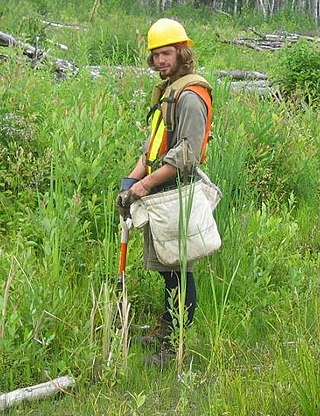
Tree planting is the process of transplanting tree seedlings, generally for forestry, land reclamation, or landscaping purposes. It differs from the transplantation of larger trees in arboriculture and from the lower-cost but slower and less reliable distribution of tree seeds. Trees contribute to their environment over long periods of time by providing oxygen, improving air quality, climate amelioration, conserving water, preserving soil, and supporting wildlife. During the process of photosynthesis, trees take in carbon dioxide and produce the oxygen we breathe.

Land development is the alteration of landscape in any number of ways such as:

Afforestation is the establishment of a forest or stand of trees in an area where there was no recent tree cover. There are three types of afforestation: Natural regeneration, agroforestry and tree plantations. Afforestation has many benefits. In the context of climate change, afforestation can be helpful for climate change mitigation through the route of carbon sequestration. Afforestation can also improve the local climate through increased rainfall and by being a barrier against high winds. The additional trees can also prevent or reduce topsoil erosion, floods and landslides. Finally, additional trees can be a habitat for wildlife, and provide employment and wood products.

The Korea Forest Service is a central administrative agency under the Ministry of Agriculture, Food and Rural Affairs (MAFR), responsible for protecting and nurturing forests, increasing forest resources, developing forest products, conducting research on forest management and improvement, and is located in Daejeon Government Complex. In the past, during the national forestation campaign from 1973 to 1986, it was temporarily under the Ministry of Home Affairs, but returned to the Ministry of Agriculture, Forestry and Fisheries in 1987. However, as the agency's work was focused solely on maintaining and managing successful national forestation policies, questions were raised about its necessity for a period of time. Currently, the agency has transformed its identity into one that strives to generate continuous income through forest resources.
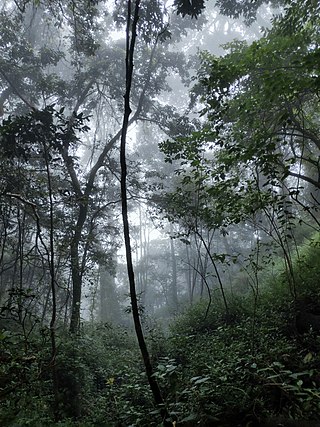
Forest management is a branch of forestry concerned with overall administrative, legal, economic, and social aspects, as well as scientific and technical aspects, such as silviculture, forest protection, and forest regulation. This includes management for timber, aesthetics, recreation, urban values, water, wildlife, inland and nearshore fisheries, wood products, plant genetic resources, and other forest resource values. Management objectives can be for conservation, utilisation, or a mixture of the two. Techniques include timber extraction, planting and replanting of different species, building and maintenance of roads and pathways through forests, and preventing fire.
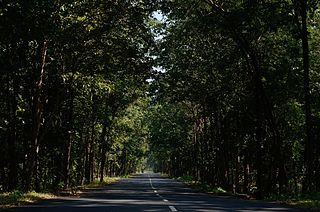
Social forestry is the management and protection of forests and afforestation of barren and deforested lands with the purpose of helping environmental, social and rural development. The term social forestry was first used in 1976 by The National Commission on Agriculture, when the government of India aimed to reduce pressure on forests by planting trees on all unused and fallow lands. It was intended as a democratic approach to forest conservation and usage, maximizing land utilization for multiple purposes.

Deforestation in Cambodia has increased in recent years. Cambodia is one of the world's most forest endowed countries, that was not historically widely deforested. However, massive deforestation for economic development threatens its forests and ecosystems. As of 2015, the country has one of the highest rates of deforestation in the world.
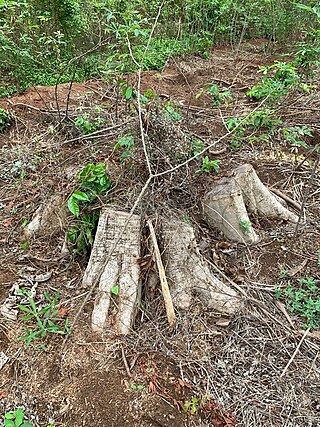
The extensive and rapid clearing of forests (deforestation) within the borders of Nigeria has significant impacts on both local and global scales.

Carbon dioxide removal (CDR) is a process in which carbon dioxide is removed from the atmosphere by deliberate human activities and durably stored in geological, terrestrial, or ocean reservoirs, or in products. This process is also known as carbon removal, greenhouse gas removal or negative emissions. CDR is more and more often integrated into climate policy, as an element of climate change mitigation strategies. Achieving net zero emissions will require first and foremost deep and sustained cuts in emissions, and then—in addition—the use of CDR. In the future, CDR may be able to counterbalance emissions that are technically difficult to eliminate, such as some agricultural and industrial emissions.

Forest conservation is the practice of planning and maintaining forested areas for the benefit and sustainability of future generations. Forest conservation involves the upkeep of the natural resources within a forest that are beneficial for both humans and the ecosystem. Forests provide wildlife with a suitable habitat for living which allows the ecosystem to be biodiverse and benefit other natural processes. Forests also filter groundwater and prevent runoff keeping water safe for human consumption. There are many types of forests to consider and various techniques to preserve them. Of the types of forests in the United States, they each face specific threats. But, there are various techniques to implement that will protect and preserve them.
CAMPA Act or Compensatory Afforestation Fund Act is an Indian legislation that seeks to provide an appropriate institutional mechanism, both at the Centre and in each State and Union Territory, to ensure expeditious utilization in efficient and transparent manner of amounts released in lieu of forest land diverted for non-forest purpose which would mitigate impact of diversion of such forest land.
Forest cover is the amount of trees that covers a particular area of land. It may be measured as relative or absolute. Nearly a third of the world's land surface is covered with forest, with closed-canopy forest accounting for 4 - 5 billion hectares of land. Forests provide many ecosystem services that humans and animals cannot survive without, but anthropogenic actions and climate change are threatening global forest cover in potentially irreversible ways.

The Icelandic Forest Service (IFS) is a subordinate agency to the Ministry for the Environment and Natural Resources of the Government of Iceland. This governmental institution works not only with and for the government but also for the public and other parties interested. The main subjects are research development, consultation work and the distribution of knowledge and know-how within the Icelandic forest sector. Furthermore, the IFS acts as Iceland's representative body for international forest-related cooperation. The Director of IFS as of 2016 is Mr. Throstur Eysteinsson. The Icelandic Forest Research Mógilsá is a research division of the Icelandic Forest Service with headquarters located at Mógilsá, near Reykjavík. The head of research is Ms. Edda Sigurdís Oddsdóttir.

Although the conservation movement developed in Europe in the 18th century, Costa Rica as a country has been heralded its champion in the current times. Costa Rica hosts an astonishing number of species, given its size, having more animal and plant species than the US and Canada combined hosting over 500,000 species of plants and animals. Despite this, Costa Rica is only 250 miles long and 150 miles wide. A widely accepted theory for the origin of this unusual density of species is the free mixing of species from both North and South America occurring on this "inter-oceanic" and "inter-continental" landscape. Preserving the natural environment of this fragile landscape, therefore, has drawn the attention of many international scholars and scientists.

The Great Northumberland Forest is a proposed new forest in the north of England. Announced in September 2019, it is intended that up to a million trees will be planted between 2020 and 2024.

Yin Yuzhen is a Chinese woman known for her personal efforts to combat desertification over the course of 30 years.
Namatale Central Forest Reserve is a forest located in Mbale district, Uganda. It is a significant natural resource that plays a crucial role in the region's ecosystem and biodiversity conservation efforts.
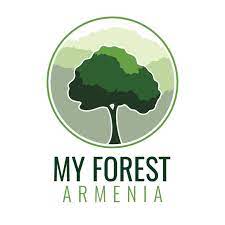
My Forest Armenia is a non-profit organization founded in 2019, in Yerevan, Armenia. The organization was established with the initial goal of offsetting carbon emissions from burning fossil fuels, which was carried out through reforestation and afforestation efforts in the Lori and Tavush provinces of Armenia. The organization planted 910,000 trees in Armenia in 2023.



















